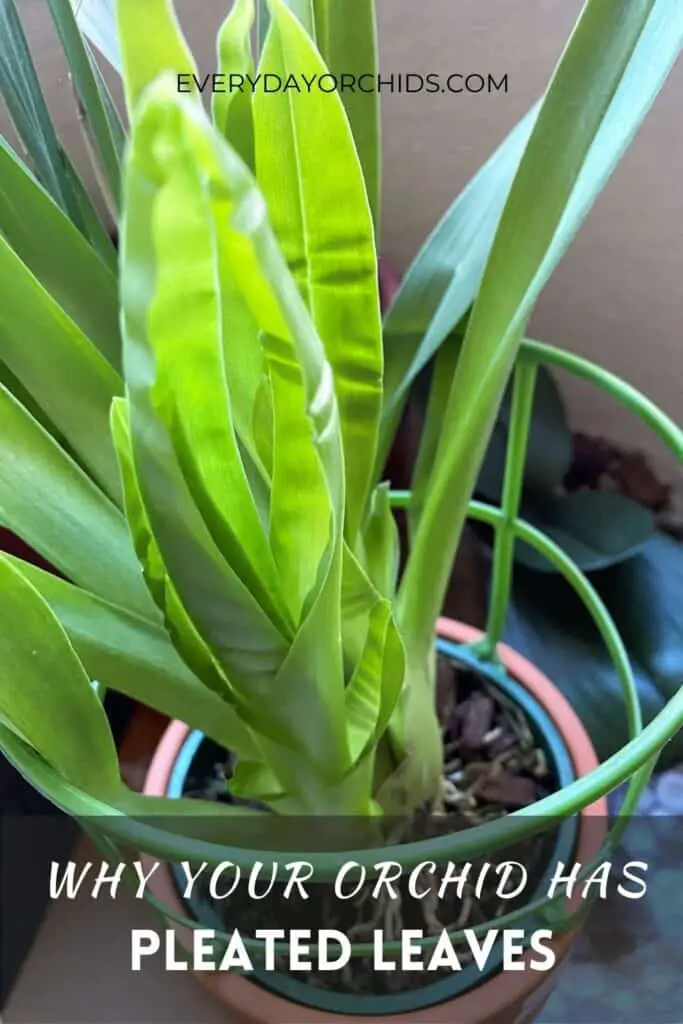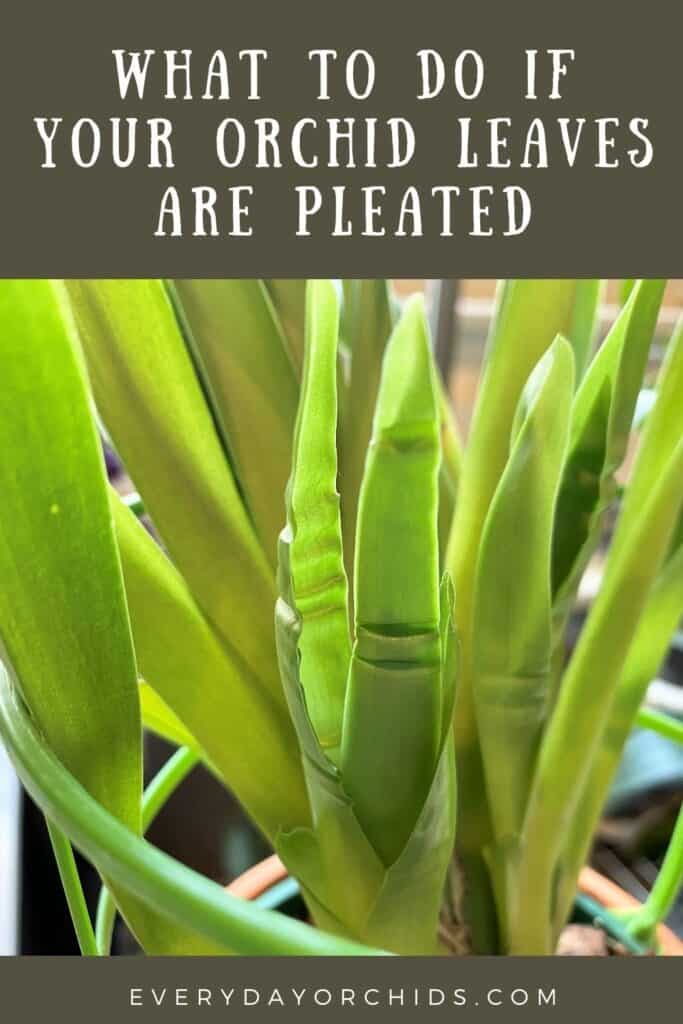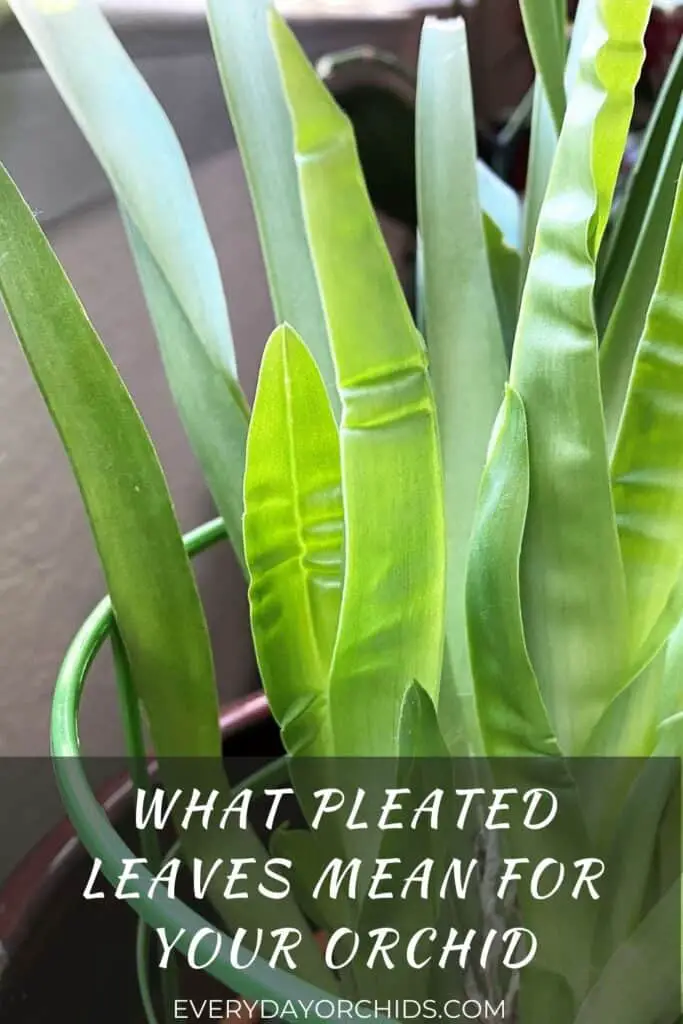In orchids with thin leaves, you may sometimes see pleated, accordion-like leaves. The pleats tend to go across the leaf in a horizontal fashion.
Why does this happen and do you need to do something about it? Here’s a hint: pleated, accordion-like leaves are not normal in most orchids. These pleats are your orchid’s way of telling you something needs to be addressed in your orchid care.
Pleated orchid leaves can occur due to insufficient watering, low humidity levels, or damaged roots. Orchids are most susceptible to this during growth periods, when new leaves and shoots are developing. If the orchid does not get adequate watering or humidity during this time of growth, it will show that in the form of pleated leaves.
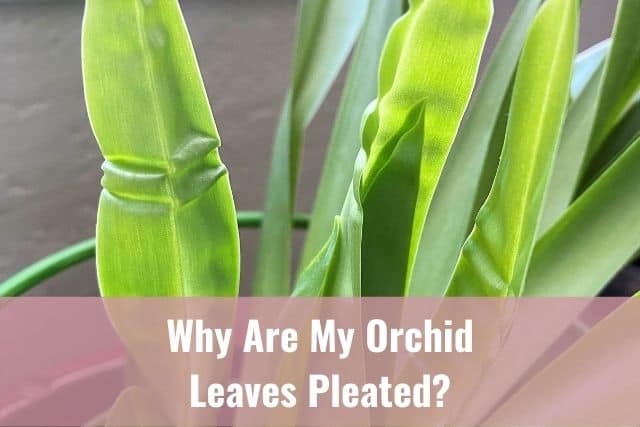
Next, I’ll go over the top three causes for pleated leaves in more detail. You’ll learn what you need to do to address it and how to prevent pleated leaves from developing again in the future.
In addition, there are some orchids which have naturally-occurring pleats and wavy leaves. Knowing whether your orchid falls into one of these groups is important, as it will determine whether or not you act on the pleated leaves. I’ll go over all of this below, so keep reading to learn more!
Please note that these links are affiliate links and as an Amazon Associate, I earn from qualifying purchases. Purchases made through affiliate links in this post may generate commissions at no additional cost to you. Use this link for a discounted Amazon Prime trial. Thank you for your support!
Table of Contents
Causes Of Pleated Leaves In Orchids
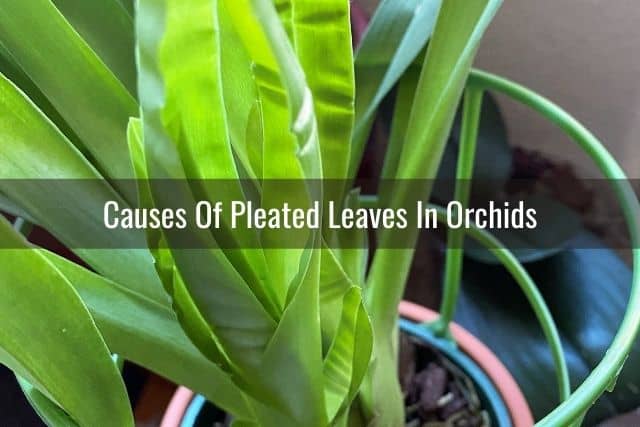
At the most basic level, inadequate moisture levels can cause horizontal pleats in thin orchid leaves. This is most noticeable when new growth occurs.
That said, there are three main causes of pleated leaves: watering problems, humidity issues, and dead or rotted roots. I’ll go into each cause in more detail below.
Watering Problems
Irregular or infrequent watering practices can lead to pleated leaves in thin-leaved orchids. This is seen most often in the spring when new growth is developing. Pleated leaves will occur if the orchid is allowed to dry out between waterings or goes for long periods without water.
Many thin-leaved orchids also have pseudobulbs for water storage. If the watering problem is severe, some of the pseudobulbs will start to become wrinkled or shriveled themselves.
Water According To Your Orchid’s Species’ Needs
Watering according to your orchid’s specific needs is key to preventing pleated leaves from forming. Keep in mind that an orchid’s watering needs, in terms of frequency, are specific to each orchid species.
Some orchid species can tolerate lower humidity levels and less frequent watering, while others require more frequent watering and higher humidity levels. It is important for every orchid grower to know what kind of orchid they have. That way, they can tailor their orchid care to meet the particular needs of their orchid.
You can read more about the basic techniques of how to water an orchid here.
Example
Case in point, I mostly have Phalaenopsis orchids right now, but I also have a few other orchid varieties, including a Miltoniopsis orchid. If you aren’t familiar with this orchid variety, Miltoniopsis orchids have higher humidity needs compared to Phalaenopsis orchids. Miltoniopsis orchids also need to be watered more frequently.
My mistake was that I started watering my Miltoniopsis orchid on the same schedule as my Phalaenopsis orchids. I knew better but the truth is, I just got lazy. It was just more convenient water all my orchids once a week rather than keep different watering schedules for each species.
However, I soon saw pleated leaves in my Miltoniopsis orchid as a result. While the pseudobulbs of my Miltoniopsis orchid remained firm and unchanged, the new leaves of the Miltoniopsis orchid came out pleated and accordion-like.
This was a clear signal that my care practices needed to change. My Miltoniopsis orchid needed more water and humidity. Through the pleated leaves, it was trying to tell me that it could not tolerate being on the same watering schedule as my Phalaenopsis orchids.
Humidity Problems
Low or inadequate humidity levels can also cause pleated, accordion-like leaves in orchids. Similar to watering needs, humidity needs will also differ between orchid species.
For example, Phalaenopsis orchids do best with humidity levels around 50%. However, Miltoniopsis orchids prefer higher humidity levels, around 50-70%.
Going back to my earlier example, my mistake was catering to my Phalaenopsis orchids’ needs and neglecting the higher moisture needs of my Miltoniopsis. I kept the humidity level around 50% for my orchids. However, this was a problem because the Phalaenopsis orchids and Miltoniopsis orchid were located in the same growing area. (I’ve since fixed that problem, by the way.)
How To Address Low Humidity Issues
To address low humidity problems, you need to first identify your orchid’s species. This will help you figure out the humidity range needed for your orchid’s growing area.
Once you have an idea of what your orchid’s optimal humidity range is, invest in a hygrometer. This will allow you to measure humidity levels around your orchid’s growing area. You’ll be able to determine if you are in or out of the preferred humidity range for your orchid.
Then if needed, you can increase humidity levels with a humidity tray, water fountain, or some other sort of device. Humidity levels often drop in the drier fall and winter months. Depending on where you live, you may need to use a humidifier to maintain humidity levels for your orchids.
You can read more about humidity levels and why they are so important for orchids on Everyday Orchids. Here are also five ways to add humidity to your orchid’s growing area.
Root Problems
Root problems are a third reason why your orchid may end up with pleated leaves. If, despite your best watering and humidification efforts, your orchid is still sending up pleated leaves, check out the roots. This might come as a surprise, but root problems can also lead to pleated, accordion-like leaves in orchids.
Think about it. If the roots are rotted or dried up and shriveled, they are unable to absorb water. If the roots cannot absorb enough water, the orchid doesn’t have adequate hydration in order to form smooth, healthy leaves. The result will be pleated leaves.
The best thing to do in this case is to unpot your orchid and remove the old potting media. Thoroughly inspect your orchid’s roots. Chances are, your orchid may have some root rot or dried, shriveled roots.
Rotted roots, or dried, shriveled roots, are dead roots. They will need to be pruned off. Use sterilized gardening shears to trim off the dead roots. Then, repot your orchid with new orchid potting media in a clean, sterilized pot.
Moving forward, water your orchid according to it’s care needs. Make sure it has adequate humidity. Keep an eye on the orchid roots and make sure they stay healthy. If you are doing things right, any new leaves will grow out straight, rather than pleated.
Can You Straighten Out Pleated Orchid Leaves?
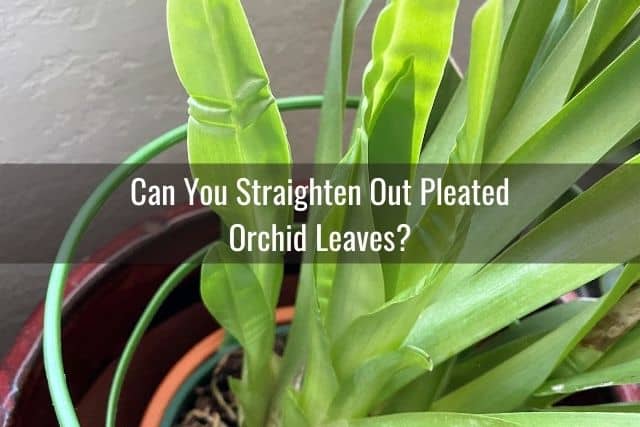
Unfortunately, once the leaves have developed horizontal pleats or wrinkles, it is impossible for them to become “normal-looking” again.
In other words, accordion-shaped, pleated leaves cannot be straightened out. Don’t try to pull on them to straighten them out either. This can cause the leaves to break or tear.
Don’t worry though, once you address what is causing the pleated leaves, any new growth should appear “normal.” With proper watering and humidity, future leaves will grow out straight and smooth.
While those accordion-shaped, pleated leaves may be unsightly, they will serve as a good reminder to stay on top of your orchid’s watering routine and humidity needs moving forward.
Are Pleated Leaves Bad For The Orchid?
No, pleated leaves are not harmful to orchids. They are mainly a cosmetic problem and would only pose a problem if you were planning to enter your orchid in a competition.
Pleated leaves are still able to perform photosynthesis and harvest energy for your orchid. Even if your orchid has pleated leaves, it can go on to live for years and do just fine. It can even produce blooms on a pseudobulb growth with pleated leaves.
However, just because pleated leaves won’t harm your orchid, this doesn’t mean that you can ignore them.
Horizontal pleats across your orchid’s leaves are indicative of a bigger problem. You will need to figure out what is causing these pleats to occur.
If you don’t work to address the primary cause of the pleated leaves, this can lead to negative consequences for your orchid. Left alone, your orchid may start to show signs of dehydration and stunted growth. In extreme cases, the orchid may even die.
Which Orchids Might Have Pleated Leaves?

There are two types of pleats you may see in an orchid: horizontal pleats which go across the orchid leaf, and vertical pleats, which go up and down the length of the orchid leaf. Vertical pleats are normal, while horizontal pleats are not.
Horizontal Pleats
Let’s talk about orchids with horizontal pleats first. Remember, if this occurs, this is a signal that something is wrong with your orchid’s moisture levels and you need to take action.
You may see horizontal pleats occurring in thin-leaved orchids such as Maxillaria, Encyclia, Cattleya and Oncidium orchids. Miltonia and Miltoniopsis orchids and their hybrids are most susceptible to pleated leaves, in part because of their high moisture requirements.
Dendrobium orchids can also have pleated leaves if they are not getting enough moisture. However, in Dendrobiums, because the leaves are shorter, pleated leaves will look more like wavy, or misshapen, leaves. In these orchids, pleated or wavy leaves are not natural and are a sign of inadequate moisture.
Wrinkled or Wilted Leaves
Phalaenopsis orchid leaves don’t become pleated or accordion-shaped because these leaves are fairly thick. Instead, Phalaenopsis leaves wilt and become wrinkled if the orchid is faced with hydration problems.
To learn more about Phalaneopsis leaves, read this guide on what to do if your Phalaenopsis orchid leaves are wilted and wrinkled. If you are wondering if you should cut off those leaves, this article on Everyday Orchids should help.
Vertical Pleats
Some orchid species have naturally occurring pleated or wavy leaves. In these orchids, pleats or waves in the leaves is completely normal and not a sign of a root problem or moisture deficiency. Examples of this include Lycaste orchids and Phaius orchids.
Vertical pleats, going up and down the leaf, are found in some other orchid species, such as Zygonisia orchids. If you see vertical pleats in your orchid’s leaves, this does not necessarily mean that the orchid needs more water or humidity. In fact, these pleats are normal and not a cause for concern.
This is why it is important to know what kind of orchid you have, so that you’ll know what is normal and what isn’t, as well as your specific orchid’s care needs. Regardless of the type of orchid you have, you’ll need to pay attention to any changes in the leaves and roots of an orchid. These are an orchid’s way of trying to communicate it’s needs to you.
How Can You Prevent Orchid Leaves From Becoming Pleated?
As the old saying goes, an ounce of prevention is worth a pound of cure. Adequate water, humidity and healthy roots are key to preventing orchid leaves from becoming pleated in the first place.
Here are some quick tips:
- Fix your humidity issues by investing in a hygrometer and supplement your home’s humidity levels with a humidifier.
- Be consistent with your watering routine and don’t let your orchid dry out between waterings.
- Pay closer attention to humidity levels and water regularly when the orchid is in a season of growth and development. This usually occurs in the spring, after the orchid has lost all of its blooms.
If you have a high needs orchid, such as a Miltoniopsis or Miltonia, consider potting your orchid in moss. These are thirsty orchids. They may do better in a moisture-retentive potting media such as moss if you can’t keep up with the required watering frequency.
You can create your own custom orchid potting mix to meet your orchid’s needs. I suggest learning about the different potting media components to help you decide what to add to your mix and in what proportions.
An orchid potting mix that has a high proportion of sphagnum moss, some perlite, charcoal, and coconut coir, and a lower mix of pine bark may work well for orchids needing high moisture. This one by RepotMe is a good starter mix for this purpose.
Initially, there may be some trial and error with the ratios of each potting mix component, as you figure out what is best for your orchid, but don’t get discouraged. You are on the right track as long as new growth is not coming out pleated. As mentioned before, existing pleated leaves will stay pleated. However, if you are meeting your orchid’s care needs, any new growth should look normal.
Final Thoughts
In summary, horizontal pleats across an orchid’s leaves are not normal and are a sign that there are issues with watering and humidity.
You will see this type of accordion-pleating in thin-leaved orchids such as Oncidiums and Miltoniopsis orchids. While these pleats won’t harm your orchid, they are a signal that you need to make some adjustments in your orchid care.
Treatment options include increasing watering or humidity levels, or cutting away dead or rotted roots. Once you make these adjustments to your orchid care practices, any new growth should develop normally.
Pleated leaves will stay pleated, but they are a good reminder to stay on top of your orchid’s care needs. Hope this helps! As always, happy orchid growing.
If you enjoyed this article, please pin it and share!
